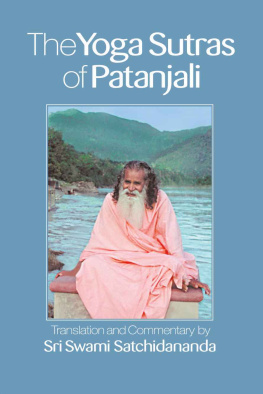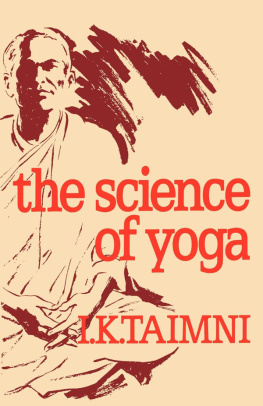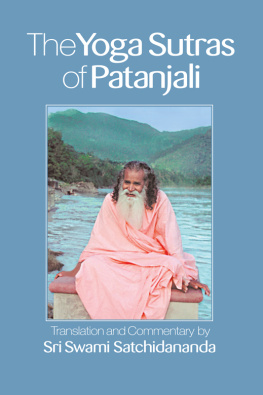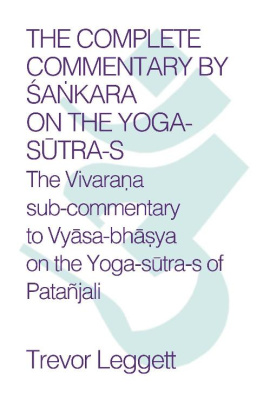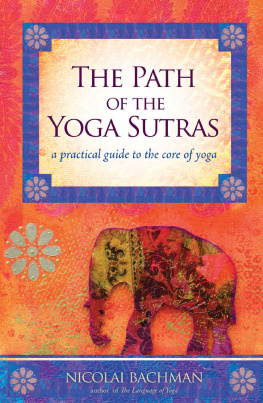

Perceptions of Truth,
The Yoga Sutras of Maharshi Patajali
By Steven M. Schorr, Sri Sri Raj Agni Satyapravaha
2013 Steven M. Schorr All Rights Reserved
No part of this book may be reproduced, utilized in any form or by any means, electronic or mechanical, including phtocopying or stored in a retrival system, or transmitted by any means without the written permission in writing from the author or publisher.
First published in May 2013 by
Agni Huna Publishing
P.O. Box 448
Puunene, Hi 96784
Email:
ISBN: 978-0-9892995-0-3
eISBN: 9780989299510
Library of Congress Control Number: 2013906865
Printed in the United States of America
Book design by Steven M Schorr
Cover photo and cover design by Steven M. Schorr
DEDICATION
TO SEVATI ROSE GABRIEI
WITH GRATITUDE, LOVE, AND AFFECTION
AND DEEP APPRECIATION FOR HER TIRELESS
ASSISTANCE IN THE EDITING OF THIS BOOK
The Yoga Sutras of Patajali are one of the most important works in the study of Yoga and form the basis of much of what we understand about the precepts of the Yogic path.
Language is a complex phenomenon in the development of human consciousness, without which society and culture could not exist. The subtleties and meanings of words reflect the people and civilizations in which they were developed. In the ancient Sanskrit language, the roots of words are revealed as having resonant significance to the energies that they were describing. The earliest Sanskrit writing describes root words called bija sounds, which were essentially 'thought forms' representing divinities or cosmic powers. These words exert their influence by means of sound vibrations. The bija sounds, literally meaning seed, were used to express the origin or cause of the underlying vibration of the words that the Vedic sages sought to communicate.
Over time through a wide application of these root words and their subsequent compounding, a complex language developed. By exploring the implications and subtleties of language and meaning etymology studies the history of words, their origins and how their forms and meanings have changed over time. Uncovering the meanings and origins of words in languages with long written histories such as Sanskrit, one can utilize their ancient texts to gather knowledge about how these words were used during their development.
A Sacred Code
That there is a sacred code hidden within the Yoga Sutras of Patajali is a novel assertion in the study, translation and commentary of the Yoga Sutras. When the process of 'harmonic resonant alignment' is applied to translation a very different and compelling message emerges. The process applied here looked at each word from the original Devanagri Sanskrit script, transliterated and then translated them into English, according to the perceived intention of the informing spirit, that of Maharishi Patajali. Then, the words were properly sequenced and interpreted.
A Diversity of Translations
Currently, there are a number of translations and commentary based on Patajali's Yoga Sutras. They cover a wide range of interpretations and include translations such as those of Swami Vivekananda in a book called "Raja Yoga"; that of an author known as Maha Sadha Ishwara (MSI), called "Enlightenment"; a Theosophical-based translation called "The Yoga Aphorisms of Patajali" by the William Q Judge; an Edgar Cayce based translation called "Edgar Cayce and the Yoga Sutras: Uniting Body, Mind and Spirit by Istavan Fazekas; a Hatha Yoga version by Swami Satchidananda; another Theosophy Trust translation by Raghavan Iyer; a Buddhist vipassana version in the tradition of Krishnamacharya by Chip Hartranft; an early western translation by Charles Johnston called "The Yoga Sutras of Patajali: The Book of the Spiritual Man"; "The Yoga Sutras of Patajali Om Edition" by Robert Odom; "Yoga Sutras for the 21st Century" by Thomas Emmerson; a modern street lingo version called "Yoga Sutras in Lingo" by Tai Sheridan; "The Yoga Sutras of Patajali - With Great Respect and Love" by Mukunda Stiles; "The Yoga Sutras of Patajali -A New Translation and Commentary" by George Feuerstein; "The Yoga Sutras of Patajali - Illuminations Through Image, Commentary and Design" by Gary Kissah; "Light on The Yoga Sutras of Patajali" by B.K.S Iyengar; " The Yoga Sutras of Patajali (Sacred Teachings)" by Alistart Shearer; "How to Know God" by Swami Prabavananda and Christopher Isherwood; "The Yoga Sutras of Patajali" by James Naughton Woods and a Kriya Yoga version called "Kriya Yoga Sutras of Patajali and the Siddhas" by Marshall Govindan.
These are but a few of the many translations available. Many have been published but some are unknown and lost in the mists of time, authored by various Hindu pundits and their western counterparts over the last two to three thousand years.
Why are there so many translations and commentaries for one book? We may conclude that the importance of this treatise is unparalleled in the understanding of Yoga. The antiquity of the treatise has provided ample time for all interested to study and comment on it. It is also clear that many schools of Yoga have referenced Patajali's Yoga Sutras to provide a basis of validity to claims that their school's techniques are appropriate and in-line with the meaning of Patajali's original intent, thus substantiating their contentions. This is true with many of the translations, throughout history. A simultaneous review and analysis of many of these translations, Sutra for Sutra read contemporaneously, will find similarities in some cases and in other cases vastly different meanings according to the authors and their individual perceptions and biases.
A Search for Meaning
The search for meaning often takes a circuitous path. Most contemporary author and translators, translating Sanskrit from Devanagri to English might reference a previously written version of the Yoga Sutras from a known and presumed reliable source. This would be a reasonable approach to guide their translation. Yet, Sanskrit is a rich and diversified language where any given word may have thirty to sixty different meanings, some antithetical and some tangential. How would an average author skilled in the use and understanding of Sanskrit select from the diversity of meanings for any given word? They may use inference or insight or they might rely upon a previous translation, whose author relied on a predecessor translation and so on.
When the process of harmonic resonant alignment is applied and the meaning of the word is selected, a higher knowledge combined with reason prevails in the process of interpretation. They are brought together to appeal reasonably to the modern mind, thus revealing a very different message. For example, in a given Sutra there may be five words and each of the words has thirty to sixty possible translations, all are valid in some context or other. The combination of meanings becomes astronomically large as the multiplication of each word combination increases the resultant choice of meanings. This is bound to create problems and contradictions.
The word meanings and their sequences take on a strange progression, as a result of a combination of factors that can best be explained by comparing it to an amalgamation of children's games. In the game called telephone a player whispers a phrase into the next person's ear. They then pass along to the next person whatever he or she has heard. The message morphs due to misunderstanding, shifting memories and interpretation. Mad Libs is a phrasal template word game where one player prompts another for a list of words to substitute for blanks in a story. The Jumble game seeks to reassemble words and phrases that have been mixed up in an anagram. Translating ancient Sanskrit is subject to a similar improbable mixture of linguistic contrivances from which a multiplicity of meanings can be extracted, leading to divergent context. Authors may attempt to accurately reflect their understanding of the subject matter, or they can be influenced by a particular bias and suggest a translation supportive of a particular understanding, teaching, lineage or school.
Next page


